| Listing 1 - 10 of 15 | << page >> |
Sort by
|
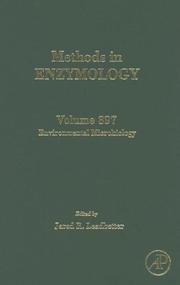
ISSN: 00766879 ISBN: 0121828026 9780121828028 Year: 2005 Volume: 397 Publisher: Academic Press
Abstract | Keywords | Export | Availability | Bookmark
 Loading...
Loading...Choose an application
- Reference Manager
- EndNote
- RefWorks (Direct export to RefWorks)
Microbial ecology --- Human Anatomy & Physiology --- Biology --- Health & Biological Sciences --- Microbiology & Immunology --- Animal Biochemistry --- Microbial ecology. --- Environmental microbiology --- Microorganisms --- Ecology
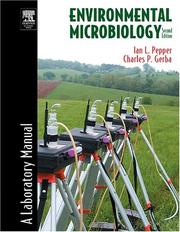
ISBN: 1280961430 9786610961436 0080470513 9780080470511 0125506562 Year: 2005 Publisher: San Diego : Academic Press,
Abstract | Keywords | Export | Availability | Bookmark
 Loading...
Loading...Choose an application
- Reference Manager
- EndNote
- RefWorks (Direct export to RefWorks)
Environmental Microbiology: A Laboratory Manual is designed to meet the diverse requirements of upper division and graduate-level laboratory sessions in environmental microbiology. The experiments introduce students to the activities of various organisms and the analyses used to study them. The book is organized into three thematic sections: Soil Microbiology, Water Microbiology, and Environmental Biotechnology. The first section includes experiments on the soil as a habitat for microorganisms, and introduces the main types of soil microorganisms, how they interact with the soil, and th
Microbial ecology --- Ecology. --- Balance of nature --- Biology --- Bionomics --- Ecological processes --- Ecological science --- Ecological sciences --- Environment --- Environmental biology --- Oecology --- Environmental sciences --- Population biology --- Environmental microbiology --- Microorganisms --- Ecology --- Microbiology
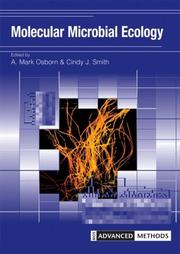
ISBN: 1859962831 Year: 2005 Publisher: New York : Taylor and Francis
Abstract | Keywords | Export | Availability | Bookmark
 Loading...
Loading...Choose an application
- Reference Manager
- EndNote
- RefWorks (Direct export to RefWorks)
Ecology. --- Environmental Microbiology. --- Environmental Sciences and Forestry. Ecology --- Microbial ecology. --- Molecular microbiology. --- Nucleic Acid Hybridization. --- Polymerase Chain Reaction --- Ecology (General). --- Methods. --- Microbial ecology --- Molecular microbiology --- 577.2 --- 579.26 --- 579.26 Microbial ecology --- 577.2 Molecular bases of life. Molecular biology --- Molecular bases of life. Molecular biology --- Microorganisms --- Molecular bacteriology --- Microbiology --- Molecular biology --- Environmental microbiology --- Ecology --- Molecular aspects
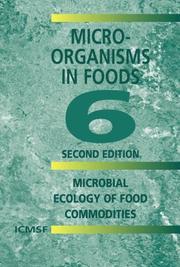
ISBN: 1280611936 9786610611935 0387288015 030648675X 1441934650 Year: 2005 Volume: 6 Publisher: New York : Kluwer Academic/Plenum Publishers,
Abstract | Keywords | Export | Availability | Bookmark
 Loading...
Loading...Choose an application
- Reference Manager
- EndNote
- RefWorks (Direct export to RefWorks)
The second edition of Microorganisms in Foods 6: Microbial Ecology of Food Commodities is intended for those primarily in applied aspects of food microbiology. For 17 commodity areas it describes the initial microbial flora and the prevalence of pathogens, the microbiological consequences of processing, typical spoilage patterns, episodes implicating those commodities with foodborne illness, and measures to control pathogens and limit spoilage. The control measures are presented in a standardized format in line with international developments in risk management. A comprehensive index has also been added. Microorganisms in Foods 5, 7, and the second edition of Microorganisms in Foods 6 are for anyone using microbiological testing and/or engaged in setting Microbiological Criteria, whether for the purpose of Governmental Food Inspection and Control or in Industry, and for those identifying the most effective use of microbiological testing in the food chain. The contents are essential reading for food processors, food microbiologists, food technologists, veterinarians, public health workers and regulatory officials. For students in Food Science and Technology they offer a wealth of information on Food Microbiology and Food Safety Management, with many references for further study. The information has been prepared by the International Commission on Microbiological Specifications for Foods (ICMSF). The ICMSF was formed in response to the need for internationally acceptable and authoritative decisions on microbiological limits for foods moving in international commerce. Currently the membership consists of eighteen food microbiologists from eleven countries, drawn from governmental laboratories in public health, agriculture, and food technology, from universities and from the food industry.
Food --- Microbial ecology. --- Microbiology. --- Environmental microbiology --- Microorganisms --- Ecology --- Microbiology --- Sanitary microbiology --- Bacteriology --- Food science. --- Chemistry, Organic. --- Food Science. --- Applied Microbiology. --- Organic Chemistry. --- Microbial biology --- Biology --- Science --- Organic chemistry --- Chemistry --- Food—Biotechnology. --- Organic chemistry.
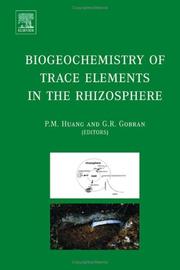
ISBN: 9780444519979 0444519971 0080457673 9780080457673 9786610638444 1280638443 Year: 2005 Publisher: Amsterdam : Elsevier,
Abstract | Keywords | Export | Availability | Bookmark
 Loading...
Loading...Choose an application
- Reference Manager
- EndNote
- RefWorks (Direct export to RefWorks)
The rhizosphere in soil environments refers to the narrow zone of soil influenced by the root and exudates. Microbial populations in the rhizosphere can be 10 - 100 times larger than the populations in the bulk soil. Therefore, the rhizosphere is bathed in root exudates and microbial metabolites and the chemistry and biology at the soil-root interface is governed by biotic (plant roots, microbes) and abiotic (physical and chemical) interactions. The research on biotic and abiotic interactions in the rhizosphere should, thus, be an issue of intense interest for years to come. This bo
Soil microbiology --- Rhizosphere --- Microbial ecology --- Soils --- Trace element content --- Soil microbiology. --- Rhizosphere. --- Microbial ecology. --- Trace elements --- Environmental microbiology --- Microorganisms --- Ecology --- Microbiology --- Roots (Botany) --- Soil micro-organisms --- Soil microorganisms --- Soil biology --- Soilborne plant diseases --- Trace element content. --- Bacteriology --- Soils - Trace element content
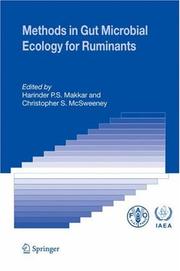
ISBN: 1280461381 9786610461387 1402037910 1402037902 9048169666 Year: 2005 Publisher: Dordrecht : Springer,
Abstract | Keywords | Export | Availability | Bookmark
 Loading...
Loading...Choose an application
- Reference Manager
- EndNote
- RefWorks (Direct export to RefWorks)
As a result of various human activities, such as increase in human population, decrease in arable land due to soil degradation, urbanization, industrialization and associated increase in the demand for livestock products, dramatic changes are occurring in the global ruminant livestock sector. These changes include shift in the size of regional livestock populations and in the types of management and feeding systems under which ruminant livestock are held, and increased demand of a wider range of quality attributes from animal agriculture, not just of the products themselves but also of the methods used in their production. The livestock sector will need to respond to newchallengesofincreasinglivestockproductivitywhileprotectingenvironmentand human health and conserving biodiversity and natural resources. The micro-organisms in the digestive tracts of ruminant livestock have a profound influence on the conversion of feed into end products, which can impact on the imal and the environment. As the livestock sector grows particularly in developing countries, there will be an increasing need to understand these processes for better management and use of both feed and other natural resources that under pin the development of sustainable feeding systems.
Rumen --- Ruminants --- Microbiology. --- Digestive organs. --- Ruminant mammals --- Ruminantia --- Artiodactyla --- Bacteriology --- Zoology. --- Agriculture. --- Ecology. --- Microbial ecology. --- Molecular ecology. --- Microbial Ecology. --- Molecular Ecology. --- Microbial biology --- Biology --- Microorganisms --- Ecology --- Molecular biology --- Environmental microbiology --- Microbiology --- Balance of nature --- Bionomics --- Ecological processes --- Ecological science --- Ecological sciences --- Environment --- Environmental biology --- Oecology --- Environmental sciences --- Population biology --- Farming --- Husbandry --- Industrial arts --- Life sciences --- Food supply --- Land use, Rural --- Natural history --- Animals --- Molecular aspects --- Ecology .
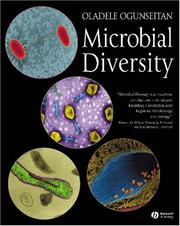
ISBN: 0632047089 9780632047086 Year: 2005 Publisher: Malden, MA: Blackwell,
Abstract | Keywords | Export | Availability | Bookmark
 Loading...
Loading...Choose an application
- Reference Manager
- EndNote
- RefWorks (Direct export to RefWorks)
Microbial Diversity offers the first comprehensive, in-depth treatment of microbial diversity for undergraduate and graduate students. Using a global approach, it illustrates the impact of microorganisms on ecological and earth system phenomena. Beginning with a detailed treatment of key concepts and methods, including the nature of microbial species, and the use of microscopic, culture, molecular and phylogenetic systematic methods, it then focuses on environmental evolution, biochemical cycling and species interactions. The text's extensive art program, including its 4-color images of microbes, will be available to instructors on CD-ROM, as well as on the web. The website will also feature an interactive microbe area. Combining molecular, genetic and microbial diversity, this textbook presents recent advances in this growing field and connects diversity with ecology and evolution. Microbial Diversity will be a vital resource, as well as an essential text for classroom use.
Microbial diversity --- Microbial ecology --- Biodiversity --- MICROBIOLOGY --- 579.23 --- 579.22 --- 574.472 --- Morphology and cytology of microorganisms. Prokaryotic cells --- Biochemistry and physiology of microorganisms --- Microbial diversity. --- Microbial ecology. --- Biodiversity. --- Microbiology. --- Biodiversiteit --- Microbiologie --- Biodiversiteit. --- Microbiologie. --- 574.472 Biodiversity --- 579.22 Biochemistry and physiology of microorganisms --- 579.23 Morphology and cytology of microorganisms. Prokaryotic cells --- Environmental microbiology --- Microorganisms --- Ecology --- Microbiology --- Diversity, Microbial --- Microbiodiversity --- Microbiological diversity --- Acqui 2006
Book
ISBN: 1281103217 9786611103217 1402034660 Year: 2005 Publisher: Dordrecht ; New York : Springer,
Abstract | Keywords | Export | Availability | Bookmark
 Loading...
Loading...Choose an application
- Reference Manager
- EndNote
- RefWorks (Direct export to RefWorks)
Decomposition of organic matter is a major ecosystem process involving an array of different organisms, including bacteria, fungi and invertebrates. The main objective of this book is to provide students and laboratory instructors at universities and professional ecologists with a broad range of established methods to study plant litter decomposition. Detailed protocols for direct use in the field or laboratory are presented in an easy to follow step-by-step format. A short introduction to each protocol reviews the ecological significance and principles of the technique and points to key references. Although most methods are described for freshwater ecosystems, many will work equally well in the presented or slightly modified form for studies in marine and terrestrial environments.
Plant litter --- Plant ecology. --- Botany --- Plants --- Ecology --- Biodegradation. --- Biodegradation --- Ecology. --- Plant Ecology. --- Sedimentology. --- Endangered ecosystems. --- Microbial ecology. --- Microbiology. --- Ecosystems. --- Microbial Ecology. --- Microbial biology --- Biology --- Microorganisms --- Environmental microbiology --- Microbiology --- Threatened ecosystems --- Biotic communities --- Nature conservation --- Petrology --- Balance of nature --- Bionomics --- Ecological processes --- Ecological science --- Ecological sciences --- Environment --- Environmental biology --- Oecology --- Environmental sciences --- Population biology --- Ecology . --- Biocenoses --- Biocoenoses --- Biogeoecology --- Biological communities --- Biomes --- Biotic community ecology --- Communities, Biotic --- Community ecology, Biotic --- Ecological communities --- Ecosystems --- Natural communities --- Phytoecology --- Vegetation ecology --- Floristic ecology
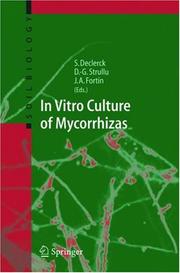
ISBN: 1280412879 9786610412877 354027331X 3540240276 3642063152 9783642063152 9783540240273 Year: 2005 Volume: 4 Publisher: Berlin : Springer,
Abstract | Keywords | Export | Availability | Bookmark
 Loading...
Loading...Choose an application
- Reference Manager
- EndNote
- RefWorks (Direct export to RefWorks)
The ?rst 30 cm of the earth’s surface represents a fragile and valuable ecos- tem, thanks to which terrestrial plants, and indirectly animals and humans, can live. The microbial activity occurring in soil is largely responsible for its physical and nutritional quality. Among the micro-organisms living in soil, the arbuscular mycorrhizal (AM) fungi play a major role. They are present in all types of soil, everywhere on the planet, living in symbiotic association with the roots of most plant species. They have co-evolved with plants for 400 million years, improving their nutrition and resistance to v- ious types of stress. Present practices in conventional agriculture, which introduce great amounts of chemicals, have eliminated or underexploited the AM symbiosis. The rational exploitation of AM fungi in sustainable agriculture, to help minimize the use of chemical fertilizers and pesticides, has been hampered by several biological characteristics of these mic- organisms: they cannot be grown in the absence of a plant host and their genetic structure is very complex. Despite these limitations, biologists have made important progress in understanding better the functioning of AM fungi. An in vitro technique has been developed using mycorrhizal root organ cultures, which made it possible to investigate the genetics, cell biology and physiology of AM fungi. We can now be objective enough to critically evaluate the impacts the in vitro technique has had to improve our knowledge on mycorrhizal symbiosis.
Mycorrhizas. --- Symbiosis. --- Consortism --- Biology --- Symbiogenesis --- Mycorhiza --- Mycorhizas --- Mycorrhiza --- Mycorrhizae --- Symbiosis --- Roots (Botany) --- Botany. --- Microbial ecology. --- Plant physiology. --- Plant Ecology. --- Agriculture. --- Soil conservation. --- Plant Sciences. --- Microbial Ecology. --- Plant Physiology. --- Soil Science & Conservation. --- Conservation of soil --- Erosion control, Soil --- Soil erosion --- Soil erosion control --- Soils --- Agricultural conservation --- Soil management --- Farming --- Husbandry --- Industrial arts --- Life sciences --- Food supply --- Land use, Rural --- Botany --- Plants --- Ecology --- Physiology --- Environmental microbiology --- Microorganisms --- Microbiology --- Botanical science --- Phytobiology --- Phytography --- Phytology --- Plant biology --- Plant science --- Natural history --- Control --- Prevention --- Conservation --- Phytoecology --- Vegetation ecology --- Plant science. --- Plant ecology. --- Soil science. --- Pedology (Soil science) --- Agriculture --- Earth sciences --- Floristic botany --- Floristic ecology --- Mycorrhizas
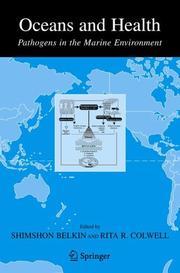
ISBN: 0387237089 9786610634200 1280634200 0387237097 Year: 2005 Publisher: New York, NY : Springer,
Abstract | Keywords | Export | Availability | Bookmark
 Loading...
Loading...Choose an application
- Reference Manager
- EndNote
- RefWorks (Direct export to RefWorks)
The importance of combating infectious diseases has received international attention, providing the opportunity for a multidisciplinary approach that combines medicine with other scientific and technological capabilities, notably information technology, nanotechnology, and biotechnology. In fact, it has been predicted that the future will bring a merging of these technologies with the cognitive and behavioral sciences—major forces that have the potential to balance the world’s inequities. The scientific community and world leaders must work together to use knowledge and its applications to improve the condition of the planet. The connection between infectious diseases and the oceans provides a paradigm for this perspective. A stark global context indisputably frames all human health issues in the twenty-first century: the world wide movement of people and goods. Throughout the past half century, international travel has skyrocketed; there are more than 500 million international arrivals per year. The greatest increase has taken place since the mid-1990s. The world has become integrated and global; consequently, the notion that it is possible to successfully eradicate a disease from the face of the planet has become simplistic. Infectious disease is a moving target and climate shifts will affect any disease that has an environmentally sensitive stage or vector. Recognizing signals from climate models and incorporating them into health measures can provide new opportunities for proactive—rather than reactive—approaches to public health. Thus, careful attention to the role of the oceans in human health can offer new avenues of research that will provide new means of predicting and preventing those diseases that are rooted in the environment. In this volume, pathogens in the sea are reviewed by Colin Munn, who provides a broader perspective for the topic of pathogenic microorganisms associated with the world oceans.
Bacteriology. --- Epidemiology. --- Marine ecology. --- Marine microbiology. --- Microbial ecology. --- Microbiology. --- Pathogenic microorganisms. --- Environment --- Hydrobiology --- Oceanography --- Environment and Public Health --- Ecology --- Ecological and Environmental Phenomena --- Earth Sciences --- Biological Phenomena --- Natural Science Disciplines --- Biology --- Health Care --- Disciplines and Occupations --- Phenomena and Processes --- Biological Science Disciplines --- Seawater --- Marine Biology --- Health & Biological Sciences --- Microbiology & Immunology --- Disease-causing microorganisms --- Micro-organisms, Pathogenic --- Pathogens --- Life sciences. --- Aquatic ecology. --- Life Sciences. --- Microbial Ecology. --- Freshwater & Marine Ecology. --- Microbiology --- Microbial biology --- Microorganisms --- Environmental microbiology --- Aquatic biology --- Diseases --- Public health --- Biosciences --- Sciences, Life --- Science --- Marine biology --- Water --- Medical microbiology --- Virulence (Microbiology) --- Aquatic biology. --- Water biology --- Aquatic sciences
| Listing 1 - 10 of 15 | << page >> |
Sort by
|

 Search
Search Feedback
Feedback About UniCat
About UniCat  Help
Help News
News